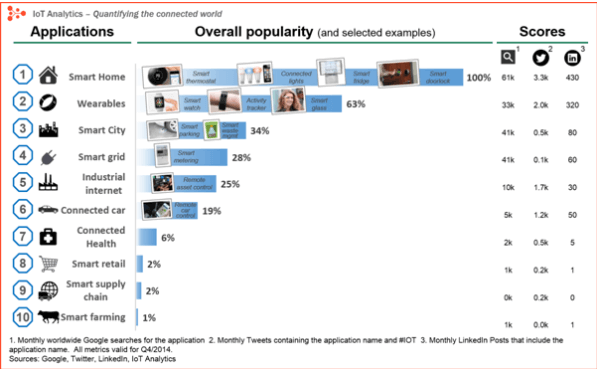IoT is not just a buzzword and it will have profound impact on our lives, the way we live and way we interact with objects around us. It is already part of our daily lives with wearable devices such as fitbit and refrigerators that can order milk automatically as soon as milk is finished. There are many more use cases and we will cover some of the use cases in this article and understand how IoT will become trillion dollar market by 2025.
IoT refers to connecting physical objects such as cars, refrigerators or other appliances to internet using embedded sensors. These embedded sensors collect information from the objects and transmit to internet. This data collected will be used to analyse the performance, security or activity of the objects. IoT is considered third wave after mobile and internet. Internet as first wave connected 1 billion people while mobile as second wave connected 2 billion people. IoT as third wave will connect 10x which is 20 billion objects to the internet.
As per McKinsey, the market for IoT will comprise of 50 to 100 billion units which will have an economic impact of $3.9 trillion to $11.1 trillion per year by 2025. Intel predicts that number of units may rise to 200 billion! The actual impact will depend on the decrease in the cost of sensors and the adoption of technology for normal work and life settings. Out of all the applications, industrial applications will have the biggest impact and contribute upto $3.7 trillion per year. After industrial applications, cities will create an impact of $1.7 trillion per year in the form of IoT related applications. Developing economies will have bigger economic impact as compared to developed economies owing to higher growth of factories and manufacturing units. In comparison, developed economies will see higher adoption rate for IoT applications. It is estimated that developing economies will contribute 43% of the economic impact because of IoT applications.
We know lots of IoT applications fall into the categories of electronic appliance and health productivity tools. Broadly, there are nine settings in which IoT can be implemented and let us see how much impact each one will have on the overall size of IoT market.
| Settings | Size in 2015-Size in2025 (in billion$) | Major Applications | Popularity on Social Media |
| Human | 170-1590 | Health and wellness | High |
| Home | 200-350 | Energy management, security, appliances | High |
| Retail environment | 410-1160 | automated checkout, smart CRM, in-store personalization | Low |
| Offices | 70-150 | Augmented reality for training, energy monitoring, building security | High |
| Factories | 1210-3700 | predictive maintenance, health and safety, inventory optimization | Med |
| Worksites | 160-930 | predictive maintenance, health and safety, inventory optimization | Med |
| Vehicles | 210-740 | Maintenance and insurance | Med |
| Cities | 930-1660 | Public safety and health, traffic control, resource management | High |
| Outside | 560-850 | Logistics routing, autonomous cars, trucks navigation | Med |
Source: BizofIT
The table given below shows how IoT related applications are popular on social media. Smart home applications such as smart thermostat, connected lights, smart fridge and smart doorlock are taking the top spot on popularity.

It is also interesting to note that the development of IoT ecosystem has further enabled the adoption of IoT. IoT ecosystem includes IoT hardware supplier, software integrators and community of industrial and consumers who are using IoT applications. The potential of economic impact by 2025 will largely depend on more secure IoT and interoperability across IoT devices and systems.
In summary, IoT applications are showing great impact in improving lifestyle and activities. People suffering from chronic diseases are using these applications to improve fitness and avoid diseases. Across all applications, we see that people are going to benefit most from the IoT in their lives from changing temperature, saving energy, getting retail offers to security at their homes and cities.







